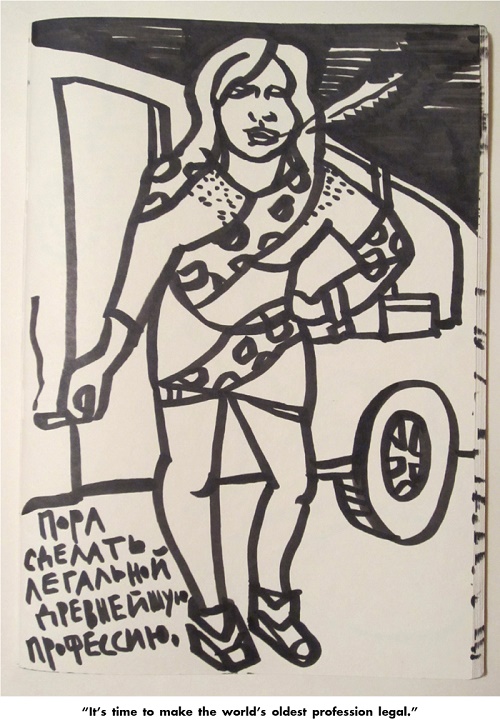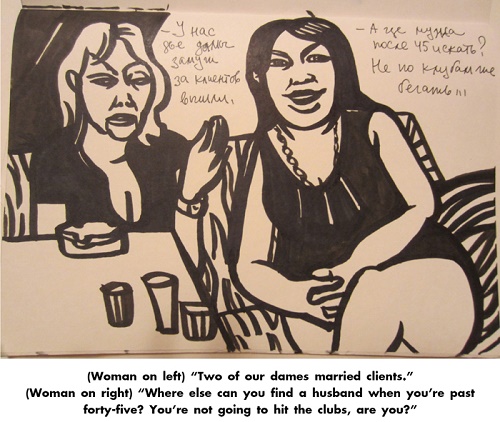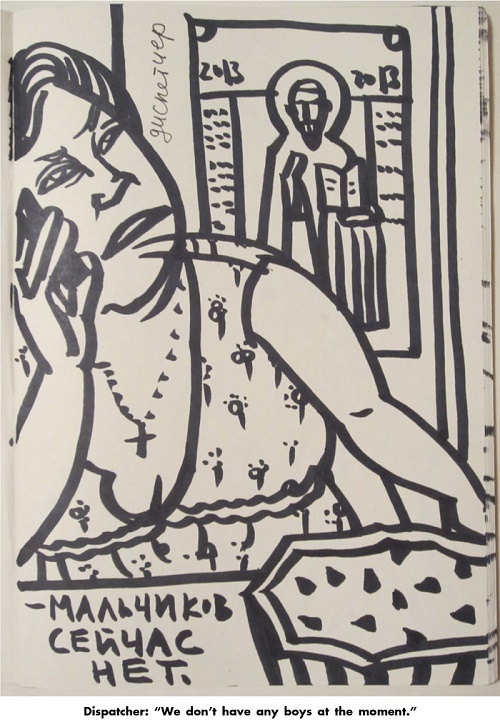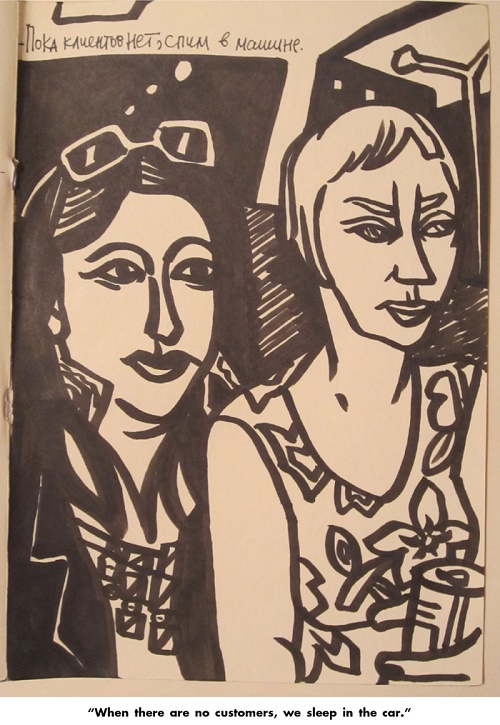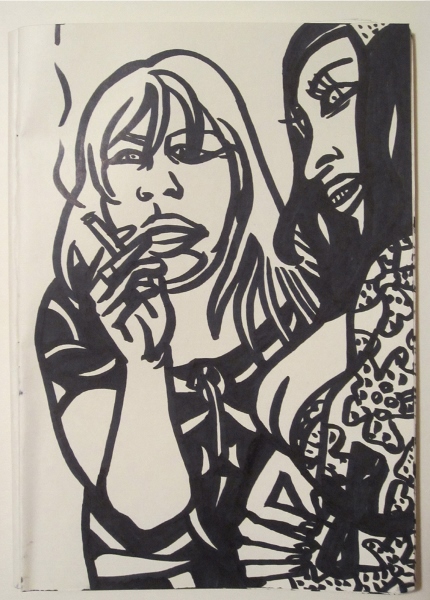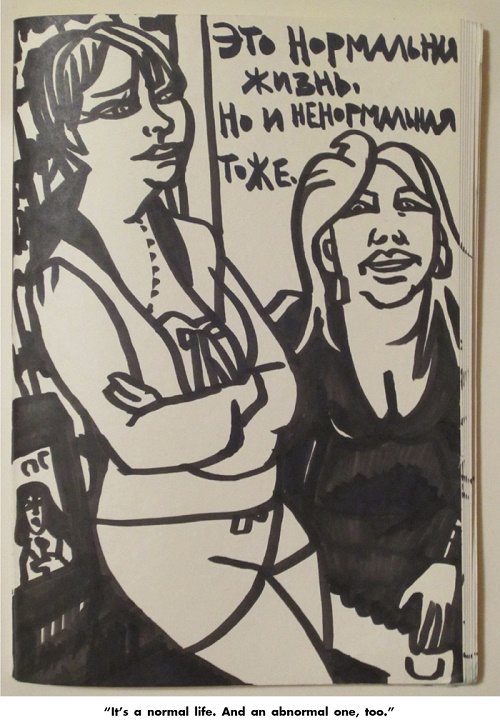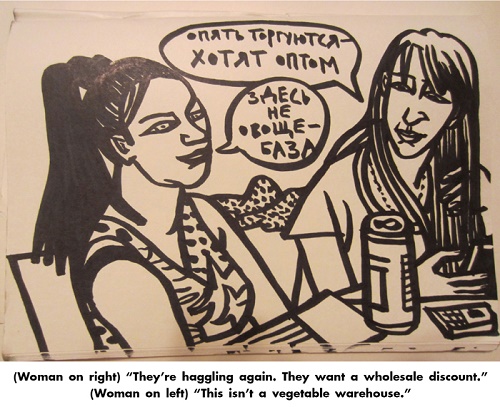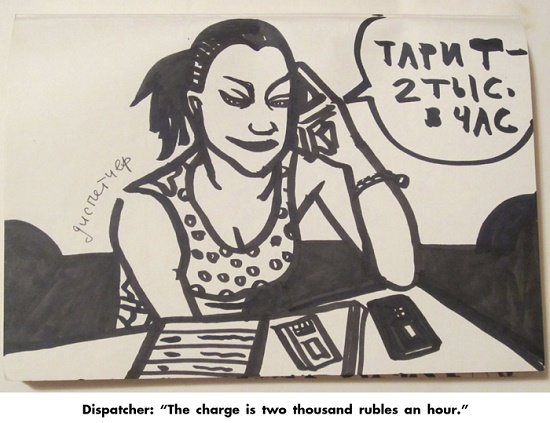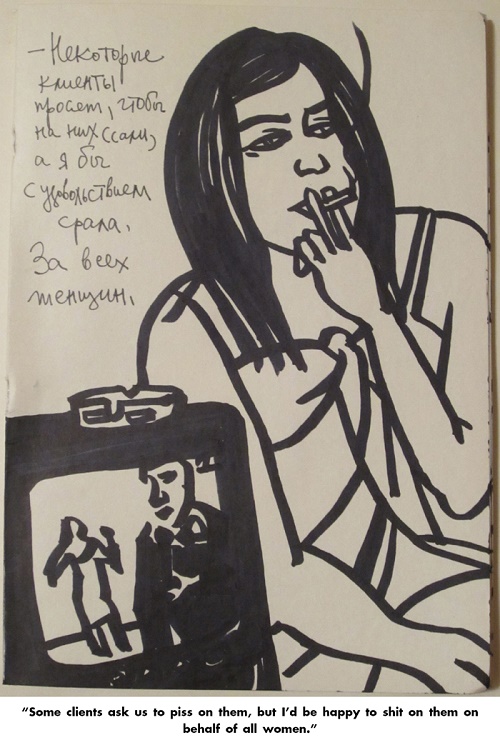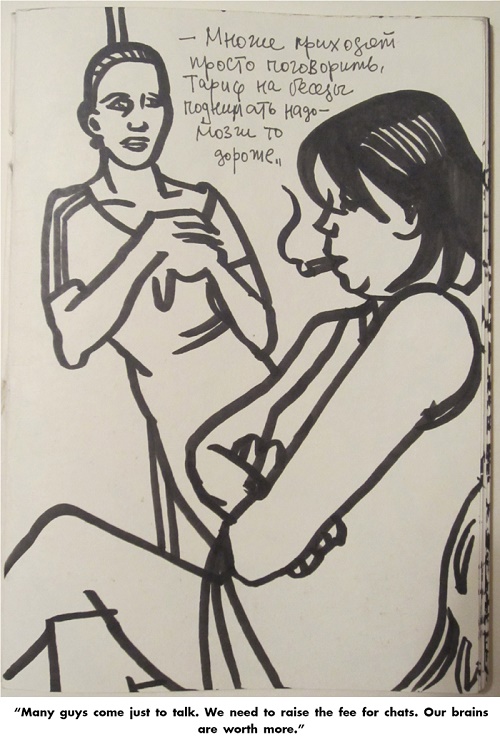I got into contact with the “girls” (sex workers) with help from Nizhny Novgorod social activist Andrei Amirov. I was able to spend between five and fifteen minutes at each “office” (a rented flat where sexual services are provided), during breaks between clients. I had to draw the series very quickly on the spot without making corrections. We made the rounds of over a dozen “offices.” It is nearly impossible for outsiders (especially women who do not work as girls) to get into an office. For me it was a valuable experience: I was able to do portraits, record the women’s own words, and ask them questions. There is a striking difference between the images of prostitutes circulated by the media and the girls I saw. The girls condemned the violent behavior of men generally (not just that of their clients), strongly criticized the authorities (officials and the police) and tried to maintain their personal boundaries even while working this job (which seems wildly unrealistic to me). I recalled times when I had been subjected to emotional and physical violence by men but had gone on claiming this was what “normal” life was like.
The rented flats where sexual services are provided are called “offices” (kontory). When they are not busy, the “girls” (devochki), the madam (mamochka) and the “dispatcher” (dispetcher) hang out in the kitchen behind a closed door or curtain, while customers are served in the “chambers” (apartamenty). I caught a glimpse of these rooms while I was making my way to the kitchen in different offices. They all look alike: a sagging fold-out couch or ottoman, a rug on the floor, a TV in the corner. Although the girls keep them clean, the rooms still look off-putting: you can tell no one lives in them. In only one of the offices I visited had the chambers been decorated. The walls were hung with long pale green curtains, which apparently were meant to remind one of a boudoir.
The girls can quit working a particular office at any moment. There were no pimps in the places I visited. As an artist, I would not, of course, have found myself in criminal haunts where women are held forcibly. As I understood from my brief interaction with the girls, such places are mainly concentrated in Moscow. The girls frequently switch offices, and they come and go according to their own schedule. In a month, they earn between thirty and sixty thousand rubles (between seven hundred and thirteen hundred euros, approximately). Many are married and work part time with the consent of their husbands. Most of them have children. Some hold down legitimate jobs at the same time. Many of the girls support their husbands or boyfriends. “When you set the table,” one advised another, “say to him, ‘Bon appetit! I nearly choked on a cock to earn that.’” One such lady, who was supporting her third or fourth husband, boasted she would be going to the sea for the first time this summer.
The women who work in the offices all look different. There are quite young women sporting T-shirts with logos, ponytails, and almost no makeup. There are tipsy fortysomething and even fiftysomething “dames” (damy) in corsets or velvet dresses with plunging necklines. Some women wear robes with nothing on underneath, a cigarette perpetually dangling from their lips. One not-so-young girl in a polka-dot cotton dress sat in the kitchen reading a dog-eared Soviet book. Most of the women looked slightly unkempt and tired, and they wore modest, homey clothing.
One girl commented on the appearance of a workmate. “Although she’s thirty-five, she looks like she’s fifty, but she continues working at the office. You can’t keep her away or get any clothes on her.”
The madams act as team leaders: they organize the entire process. Madams are often former girls, and some of them continue to provide sexual services.
A new type of madam has emerged: energetic young women who have never worked as prostitutes, they simply run the offices and take a cut of the profits. There are also cases when the girls are self-organized and work without madams.
Each team also has a dispatcher, a woman who answers phone calls from customers. At some offices, the girls take turns working as dispatchers.
According to the girls, their clients are largely either “losers” or “wogs” (churki). When there are a lot of clients, they joke that there must be a holiday at the mental hospital.
“We know both sides of men. Guys are jerks.”
“All of them?”
“No. There are also studs. They’re like dogs: they want to get out of the house and live it up.”
“Who are the strangest customers?”
“The ones who come in women’s lingerie, want to do a striptease themselves and get fucked with a strap-on. Many guys come here because their wives refuse to do fairly simple things. Sometimes, customers offer to buy girls in bulk at a discount. Everyone wants a freebie.”
The dames are more loyal to their customers than the girls are to theirs. Many dames have married former customers. Customers often visit the dames just to have a drink and a chat. They are charged separately for this.
Some girls are willing to serve people with disabilities. This is considered exceptional professionalism. The parents of a young man with cerebral palsy used to send holiday greetings to a girl who had agreed to provide their son with sexual services, regarding her almost like a member of the family.
Do the girls want their profession legalized? I asked this question in every office I visited, getting very different answers. The girls who had been to Europe liked the way prostitution is regarded in some countries there as a normal paid service.
One girl told me how she had worked in Germany, where Russian prostitutes were at odds with the African women.
“Even the Negro women fear Russians, because the Russian people are the nastiest.”
The middle-aged dames were afraid they would not earn anything if they were forced to pay taxes. “With taxes, we would have to work even harder to support ourselves and our families.”
The state would then, it turns out, take on the role of pimp.
One dame was indignant about an official who, during a TV interview, proposed legalizing prostitution and using the funds raised to build roads.
“It’s the cops who make legalization necessary.” The girls at all the offices I visited agreed on this point. Policemen hold “unpaid work days” (subbotniki) during which they force the girls to service them for free. Girls who had been “on tour” in Moscow told me what it was like. “In Moscow, cops patrol the street lineups (tochki) and take a cut from each client. So the women have to serve more clients to make money.” It is much tougher in the capital. One girl came back from a “tour” sporting a scar.
“Officials are against legalization, but all of them are our clients,” the girls said ironically. “Many officials run their own offices under the guise of massage parlors.”
“Does life ever pan out for girls like in Pretty Woman?” The girls laugh. “Rich men are only like that in the movies! But in real life, they’re like that until the first quarrel. Then they remind us of all our faults.”
Some girls end up as kept women, but they usually earn no more that way than working at an office. The men who pay the women can require them to perform a variety of services, including changing their appearance, completely isolating themselves from society, and bearing children for them. “She is now sitting home like a dog,” the girls said of a former comrade whom a married client keeps isolated in a rented flat, constantly forcing her to lose weight and look like a boy. I remarked that this sort of control of women and coercion existed in ordinary families as well. All the girls agreed with me. It was clear that many had experienced it firsthand.
This dame was fifty-five. She also worked a legitimate job and was now glad she could retire with a pension. Not all the dames have a pension to look forward to. Those whose only income has come from sex services will get work as shop clerks, cleaners, and in other low-skilled positions to make ends meet. Many of the fortysomething women fear the day when clients stop asking for them.
The young girls wonder where they would go, given their lack of higher education. The dames who do have a higher education but do not have a salary they can live on, believe that “dirty” work is dirtier than prostitution.
Both groups of women were firm about the fact that what they did was a “normal” job. And they all agreed that if other decently paid work were available, they would not stay in prostitution.
This was an office run by a former factory worker, a sixty-year-old woman with diabetes. She turned a room in her flat into so-called chambers, and herself into a dispatcher. Her daughters had once had to work as prostitutes to earn money for the family, but they had now called it quits, because what their mother now earned was enough for everyone. The daughters had got married, and the factory-worker-turned-dispatcher had recently become a grandmother for the fifth time. She sympathized with all the girls, especially the ones who “work[ed] lineups and whose only salvation [was] sanitary wet wipes.” She told me about a girl who had recently died. She had been ill with pneumonia for a long time but had kept working anyway.
Call girls (girls without their own chambers or offices) can work out of cars and vans. I spent time in one such minivan. Four girls sat crowded together on the seat opposite me. While they waited for clients to call, they drank wine from a box and beer from cans, the rhinestones on their outfits and their gorgeously painted eyes glittering. Unlike the office girls, they had the special charisma of people for whom the risk of death had become commonplace. A scar cut across one girl’s face. Working on call is more dangerous than working in an office, because it is harder to protect yourself from infection and violence from clients. But it is even more dangerous to work on the street, on a lineup. The girls who work the lineups are mostly heroin addicts and would not be hired to work in the offices. They are also often infected with syphilis, hepatitis and HIV. But clients stop for them anyway, even ones driving expensive cars. I suspect they are attracted by the scope of these women’s personal degradation, which makes it easier to treat them like things.









